
Newsletter of the Shell Club of Sydney
NSW Branch, The Malacological Society of Australasia Limited ACN 067 894 848
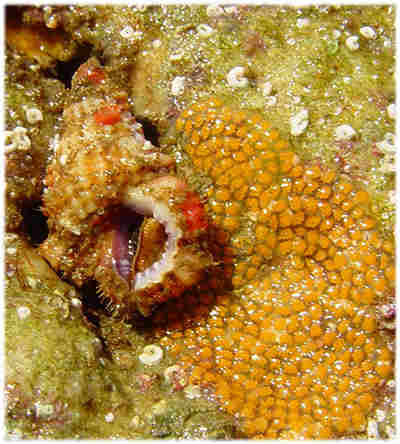
The Ranellidae, Gyrineum lacunatum (Mighels, 1845). Possibly on a clutch of eggs. Low tide, Little Bay, Sydney.
11/04/2002 Chris Barnes
Shell Club Minutes 27/10/2001
The meeting was opened by Patty Jansen at 3.00 pm, following the Annual Shell Show.
General Business:
Peter Pienaar suggested that we should try to get a mention of the monthly meetings in the Ryde Eastwood Leagues Club News Letter.
Patty introduced and welcomed new member Catherine Kindt to the club.
Western Australia Shell Club is intending to lodge a bid to host the 2004 National Shell Show.
Christmas Field Trip: Norah Head Sunday 2nd December (depending on tides).
Christmas Dinner: at Ryde Eastwood Leagues Club in the Hawks Nest Restaurant at 7.00pm on Saturday 8th December.
Meeting closed at 3.15pm
C. & K. Barnes
Secretary
Shell Club minutes 24/11/2001
The meeting was opened by Patty Jansen at 2.05 pm.
Dr Dan Geiger, visiting speaker, Malacologist and author of the Haliotidae segment of the Iconography series, was introduced and welcomed to the meeting.
Reports: Ron reported on a recent trip to Swains Reef. Shelling was not as exciting as it had been previously with hardly any shells found.
A new Zoila marginata ketyana bataviensis Lorenz & Morrison has been described from Western Australia.
Field Trip: Norah Head next Sunday. Meet at 1pm for a picnic lunch.
Christmas Party dinner confirmed for 7pm on the 8th December. A three course meal will cost about $26 per person.
General Business:
Michael distributed copies of Waves and Ripples.
Anyone wanting to exchange shells with someone in St Barts please see Patty.
MSA National Council discussion. The subscription has been increased to $70 (plus $5 for an extra family member) Australian members and $100 for overseas members, per annum. Subscriptions are due on 1st January 2002. Council has formed an agreement with CSIRO Publishing, to produce the MSA Journal. CSIRO are an independent group with worldwide distribution and marketing of scientific publications. There is no shortage of material so the journal will be published three times per year and will hopefully achieve international status.
It is believed that the MSA worldwide membership will increase as a result and that graduates will no longer have to be published overseas due to a lack of local interest.
A deal has been struck which will see 50% profit sharing with the publisher after 3 years. The Australian Shell Newsletter will remain unchanged as will Branch rebates. Peter Pienaar asked if a non-professional membership could apply, where for a lesser price the Newsletter would still be received but not the scientific journal. After discussion, a motion was put by John Franklin "That the NSW Branch of the Malacological Society of Australasia requests that a new non professional membership level be established with the subscription rate to remain at $40 per annum." Seconded by Peter Pienaar. Passed unanimously.
Treasurer's Report:
John Franklin tabled the accounts - credit of $1520 as of October 2001.
Presentation:
Dr Dan Geiger gave an informative presentation on Evolutionary Patterns and Processes in Abalone and their Relatives. The talk included the view that of the approximately 200 species of known Abalone only 56% are valid. Biogeographical distribution of species including the search for an evolutionary point of origin., Vetigastropods' interrelationships and shell morphology (intermediaries and variations) questioning whether these shells started off small and grew larger over time (peramorphic) or vice versa. Dr Geiger answered a number of questions from the group and was offered a vote of thanks from all for his efforts.
Meeting closed at 3.22pm
C. & K. Barnes
Secretary
'Chocolate'
Cypraea coxeni?
David Tarrant
The shell pictured below was collected by shell identity Wal Gibbins from Sassavelli in the New Georgia Islands, located in the Western Province of the Solomon Islands.
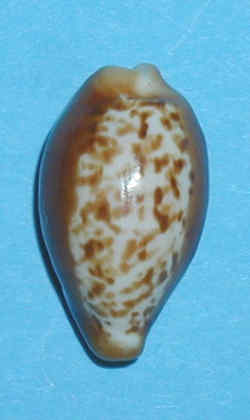 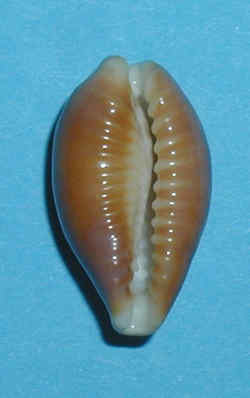
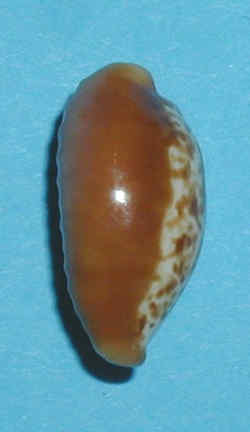
The shell shape and the dorsal colour are typical of the Cypraea coxeni
from the Solomons, but the sides and base of the shell are coloured chocolate brown. The colour appears to be a deeper brown than the rust colour that sometimes occurs in Solomon Island cowries taken from war wrecks.
Assuming that the shell is Cypraea coxeni, it is difficult to say what caused the unusual colour. Perhaps, like the rest of us, it ate too many Easter eggs!
I would be interested to know if anyone has come across similarly coloured shells.
Urchins at the National Shell Show.
As usual Vincent Crayssac had a spectacular display of top dollar shells for sale. He also had a pair of eye catching deep water New Caledonia urchins. As well as the spines being very long and colourful, the tests had striking colours.
Both were purchased by Sydney members. - Ashley Miskelly and Steve Dean
Vincent transports these urchins with their spines in a plastic bag, and then re-glues the spines at the shows.

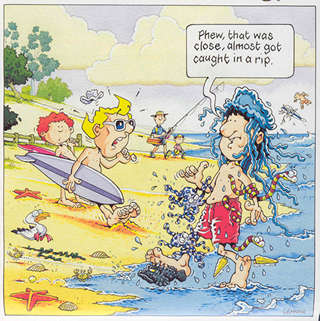
(The cone shells seem to have
their harpoon on the wrong end!)
Courtesy, Barbara Collins
Beach magic
James Woodford
Courtesy - Fairfax Publications Sydney, Section: Good Weekend, Publication date: 12-1-2002, Page no: 12
They're home to oiled bodies, striped brollies, sandcastles. Oh, and three-metre-long flesh-eating worms. There's more to our famous beaches than meets the eye. James Woodford goes digging.
Few people on Earth love the beach as much as Australians, and, luckily, our lust for that intoxicating mix of sand, water and salt can afford to be insatiable. Give or take a few hundred, this country has 10,000 beaches. In NSW alone there are 721, averaging 1.6 kilometres, the longest - Ten Mile Beach in the far north of the state - stretching for 28.5 kilometres. Victoria has 588, averaging 1.4 kilometres, the longest measuring a whopping 222 kilometres. (The very approximately named Ninety Mile Beach, on the east coast, is the longest stretch of coastal sand in the nation, but is broken by Lakes Entrance and several small rocky outcrops. The longest unbroken beach, at 194 kilometres, is at the Coorong in South Australia.)
Around 80 per cent of Australia's beaches are nameless, without two-wheel-drive access, visited only by the occasional secretive fisherman or lucky local. It is still possible on the shores of this continent to get your gear off and run naked into the surf with nobody but a baffled sea eagle looking on.
All beaches have things in common but, just like faces or fingerprints, no two anywhere are absolutely identical. Beyond its geographical backdrop - be it wild, forest-topped cliffs or cafes and car parks - what makes each strip of sand distinctive includes things you might never have given much thought to: wave height, tide patterns and even the size of each grain of sand.
WAVES: Wave patterns vary from state to state. Victorian waves average close to 2 metres, while in NSW the average is 1.5 metres. Victoria's bigger swells - other than in Port Phillip Bay - are a result of being close to the forbidding Southern Ocean and more exposed to the westerly winds. And since the power of a wave increases at the square of the height, the Victorian surf has a higher energy and greater erosive force - and Victoria's beaches change more rapidly, rarely looking the same two days in a row.
This simple scientific fact has a direct impact on one of the world's truly great religions - bodysurfing. If you're looking to imitate a dolphin, you need spilling waves, the ones that roll in and slowly break at the top. Board riders favour waves with a steep face. While there are exceptions to this generalisation, NSW is bodysurfers' heaven, whereas Victoria is paradise for waxheads.
By the way, many people think that it is the wave that carries a bodysurfer in to the shore. In fact, it's the foam. Before the wave breaks, the water is only moving up and down - not until there is foam is the water actually moving forward.
TIDES: Tides are different everywhere in the world and most Australians who live in NSW and Victoria know that in each day there are two high tides and two low tides (while in parts of Western Australia, for instance, they're satisfied with one). The main cause of the tidal movement of water is the gravitational pull of the moon, but the sun, too, helps pull our oceans up onto the land as easily as a quilt being dragged over a bed. To begin to get a sense of the force of the tides, says former Australian Museum scientist Phil Colman, take a bucket down to the sea, fill it in the surf, then carry it 50 metres up the beach. As you rest your aching arms, imagine the energy at work when a vast slab of the Pacific, Indian or Timor is lifted up whole metres across the entire ocean. The tide is itself a wave, consisting of a crest and a trough, but on a grand scale. At high tide, the crest of the wave hits the shore; low tide is when the trough arrives.
The reason tides creep forward each day (low tide will be roughly an hour later tomorrow than it was today) is that each of the four ebbs and flows takes about six hours and 12 minutes. This is because the mean lunar day is 50 minutes longer than the mean solar day. At Christmas time beachgoers are tuned in to the tides and so notice extreme highs and lows - known as spring tides. But in fact these occur throughout the year. As Isobel Bennett writes in her exquisitely beautiful - though, shamefully, out of print - book, Australian Seashores: "In general it is important to remember that the size of the tide bears a close relationship to the phases of the moon as it waxes and wanes. The small neap tides occur when the sun and moon pull against each other - at the first and last quarters of the moon - and the large spring tides when they pull together at the time of the new and full moon." For those charged with predicting the tides, there are other confusing factors to consider; weather for one. A big low-pressure system can add up to 80 centimetres to the height of a tide; winds can cause havoc.
As Andy Short, director of coastal studies at the University of Sydney, points out, Australia's countless different tidal patterns have had a profound effect on the creation of different types of beaches. For instance, the difference in height between high and low tides is far greater in northern Australia than in southern Australia, partly due to the amplification of tides between the Indonesian archipelago, Papua New Guinea and northern Australia, combined with a gently sloping continental shelf. The beaches there are wider, flatter and more featureless than, say, Bondi or Bells Beach. Down south, the force of the sea is concentrated for longer periods on a thinner band of the sea floor, allowing gutters and sandbars - hence rips - to develop. (A rip is merely an attempt by water to rush back out to sea through the carved sandbars that form in the surf zone.) Up north, says Short, the tides tend to do little more than sweep the slate clean.
Without the tides, our beaches would turn into filthy garbage tips. According to Phil Colman: "Every time the tide comes in, it wipes away our faults ready for the next onslaught. People don't think about where the rubbish is taken by the tides, what happens to it." Around the planet, billions of items of plastic make their way into the sea each year. They are at the mercy of currents and can float thousands of kilometres, constantly threatening marine animals like turtles, which mistake the rubbish for creatures they normally eat, like jellyfish. Sydney's beaches are home to an average of 2,600 pieces of litter per kilometre.
SAND: To true beach lovers, sand is something to squish between your toes, the essence of summer; to others, it's the cursed stuff that falls into the cracks of the car and the cossies and stays there. And to some scientists, it's also highly distinctive. Hand these experts a thimbleful of grains from Wilsons Promontory or Bondi and they'll identify it as easily as they would their Mum.
John Hudson has spent his life learning to identify what sand comes from which beach and how it affects seashore topography. Our sea levels have been relatively stable for 6,500 years and over that time beaches have acquired their own highly distinctive "provenance sand".
"The beaches are tuned to the material available and the prevailing wave climates," he says. This has important implications for those wanting to renourish a beach after a storm: take sand from Avalon and use it on Bondi and it will behave completely differently from provenance Bondi sand. Not only will it be a different colour - much redder - but chances are it will simply wash away because it is not the right sand type to remain at Bondi in the long term.
Because of the physics of how particles behave when they're stacked on top of each other, the size of the sand grains is of the utmost importance to the shape and even the feel of the beach. The general rule is that the finer the grains of sand on the seashore, the more gently the beach will slope. (A gravely or stony beach will be the steepest of all.) Likewise, the finer the sand, the firmer the beach. The immense Seven Mile Beach, south of Gerroa on the NSW south coast, has sand that washes straight from the Shoalhaven River and its grains are so fine they are almost like silt; taking a run along its surf zone is like pounding along a city pavement.
Light-coloured sands are full of quartz and feldspar. Redder sands often contain iron, and dark patches can indicate a soup of heavy metals. Generally, Sydney beaches have yellow tinges because of iron staining - though this is much more marked north of Sydney Harbour. Victorian beaches are much more variable in their colouration. The whitest beaches in the continent are at Cape Le Grand National Park, near Esperance in Western Australia. They are almost pure quartz.
The actual grains of your favourite beach have been part of the coastal drama for untold millennia. Each sand grain is a time traveller, often from geological eras tens of millions of years ago. Before the sand was sand, it was stones and pebbles. Before that it was rocks, and even further back in time it was mountains. There is a very high chance that when you run your hand through the warm grains on a beach in Port Phillip Bay, thousands of tiny fragments of the supercontinent Gondwana are slipping through your fingers.
BEACH LIFE: The beach wasn't created for our entertainment - it is an awesomely rich ecosystem. Mostly out of view, living under the sand and making up the grunt of the beach ecosystem are the civilisations of invertebrates which in turn feed on invisible armies of micro-organisms. Bigger creatures include swarms of three-metre-long worms that would just love for us to die while we sunbake on our towels - their favourite fare is rotting meat.
"They are exceedingly common on many of our ocean sand beaches," Isobel Bennett writes. "The worms live completely hidden in the sand where the surf breaks at low-water mark and where one might be excused for claiming that no life could exist."
Fishermen know that they make fantastic bait and use putrefying flesh dragged over the wet sand to entice the worms out of their holes. Even more impressive than their huge size is the fact that they have a set of jaws powerful enough to crack open pipis or give a human trying to catch them a nasty bite.
Higher up the beach, millions of ghost crabs live and scavenge in the dry sand beyond the highest tides. Sit quietly on a beach at dusk and it is possible to watch these crabs pull morsels down into their holes.
The beach is full of such unexpected comings and goings. The closer you look at the sand, the harder you think about the life of the seashore, the more mesmerising it becomes.
Phil Colman has dedicated himself to learning about the intricacies of one small, beautiful place - Long Reef, at the south end of Sydney's Collaroy Beach. Being with Colman on Long Reef, and watching him pull creatures I'd never seen out of rockpools, turned this prosaic stretch of headland into the Great Barrier Reef. At one point he rolled over a rock and life scattered like a crowd frightened by gunfire. "If I left that facing the sun," he told me, "then 50,000 creatures would die."
A rockpool is a boom and bust environment where even a heavy rainfall that lowers salinity can destroy an entire community of animals. Even so, some animals such as sea anemones - those squidgy creatures almost every child has stuck their fingers into - can live to enormous ages. One survived in captivity for 70 years, but no-one knows their longevity in the wild.
Anemones belong to one of the slipperiest groups of animals on earth - the Coelenterata, which also includes jellyfish and bluebottles. Most people loathe these animals and are blind to their beauty and strangeness. As Bennett says, they are far removed from a typical terrestrial animal "that is a more or less elongated creature with head and mouth at one end ... which goes in front as the animal walks, swims or crawls".
When you stick your finger into an anemone, you are poking it in the mouth. The scary, dangly bits of the giant jellyfish we see floating in our estuaries and in the sea are also actually their mouths. In Sydney these jellyfish are brown or creamy because of the plant cells in their jelly, whereas in Melbourne and Brisbane they are blue. One jelly-type creature frequently seen lying stranded in the sand is commonly known as horseshoe or sausage blubber. Each blubber is around 10 centimetres long, the diameter of a sausage and curved. In spite of what many people assume, they have nothing to do with jellyfish. They are in fact the egg mass of two species of sand snail.
Another common find on the sand is the stranded bluebottle or Portuguese man-of-war. Each individual bluebottle looks like a single animal but it is actually a colony of animals living together. One individual is the float, another the feeding apparatus and an army of other individuals are specialised forms designed to poison prey such as fish. Together they bob on the sea acting like a single animal, totally at the mercy of wind, tides and ocean currents.
Inside its float the bluebottle holds a breath's worth of nitrogen and oxygen, a parcel of the sky captured within a bubble which not only keeps the bluebottle at the surface, but also acts like a sail. Because they cannot propel themselves or control their direction, bluebottles are doomed to sail until they die or run ashore. When they are blown onto the beach, life gets really tough. Lying exposed on the sand, the invertebrates are burned into cellophane by the sun, eaten by ants or crabs or popped by kids.
By the first day of this summer, a humid nor'-easter was already blowing a flotilla of bluebottles onto a little wild beach on the far south coast of NSW. The poisonous little invertebrates tumbled end over end in the surf, looking like miniature zeppelins that had crashed and become tangled in blue guy ropes.
At the high-tide mark were thousands of the stranded predators. Colman had told me that if I wanted to know why bluebottles only float in to shore on particular winds, I should line up as many of the creatures as I could in a row on the sand. "When you do," he had told me, "you will see that all of the floats are oriented the same way. They will all be different sizes but their floats will be facing the identical direction in relation to their bodies."
I collected more than 10, picking them up gingerly by their slimy bubble, and placed them side by side. Sure enough, they were all the same. At sea, this would mean that when the wind blew, their sails would be set for the same destination. During that whole afternoon I could find only one bluebottle constructed differently.
"Out in the ocean," Colman told me, "there are other bluebottles whose sails face a different direction and they never float ashore."
The national medical officer with Surf Lifesaving Australia, Dr Peter Fenner, is one of the nation's leading experts on bluebottles. "There are bluebottles with the float on the left-hand side of their bodies and bluebottles with the float on the right-hand side," he says. "This is so they don't all kamikaze at the same time." It means that half the population will survive, no matter which way the wind blows.
The only bottles that normally would intrigue a human at a beach are those with a message in them. Standing on the sand on the south coast I realised, however, that in fact a bluebottle on the beach is the opposite - a bottle surrounded by a message. The message is life and we have a long way to go before we understand it.
|






